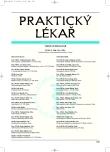The day to day life of Czech diabetic patients: Psychosomatic problems of diabetes.
Psychosomatické problémy diabetes mellitus – jak se žije diabetikům v Čechách
Vysoký počet osob postižených diabetem si zaslouží věnovat pozornost nejen problémům diagnostiky a léčby, ale i dopadu choroby na osobnost diabetiků s důrazem na okolnosti provázející jejich život. Změny, které se začleňují do pracovního a rodinného života diabetika při manifestaci onemocnění a v jeho klinickém průběhu, mohou vést ke zlepšení odborných ukazatelů, ale mohou mít negativní nežádoucí vliv na kvalitu života.
Klíčová slova:
Diabetes mellitus, kvalita života.
Authors:
Dryákovám.
Authors‘ workplace:
Ředitel: doc. MUDr. Vojtěch Hainer, CSc.
; Endokrinologický ústav Praha
Published in:
Prakt. Lék. 2007; 87(3): 162-164
Category:
Of different specialties
Overview
The large number of individuals suffering from diabetes mellitus warrants attention to be focused on the impact this disease has on patients and their lifestyle, as well as on the problem of diagnosis and treatment. Changes, which are integrated into the lifestyle of the diabetic when disease strikes and throughout its clinical duration, can lead to an improvement in specialised parameters, but they may have a negative impact on the quality of life.
Key words:
Diabetes mellitus, quality of life.
Labels
General practitioner for children and adolescents General practitioner for adultsArticle was published in
General Practitioner

2007 Issue 3
- Metamizole vs. Tramadol in Postoperative Analgesia
- Memantine in Dementia Therapy – Current Findings and Possible Future Applications
- Metamizole at a Glance and in Practice – Effective Non-Opioid Analgesic for All Ages
- What Effect Can Be Expected from Limosilactobacillus reuteri in Mucositis and Peri-Implantitis?
- Hope Awakens with Early Diagnosis of Parkinson's Disease Based on Skin Odor
Most read in this issue
- Testosterone replacement therapy in aging men.
- Drug-induced gynecomastia
- ACTH-dependent Cushing’s syndrome due to a carcinoid tumour Cushing’s
- Thyroid cancer and malignant lymphoma – is there a relationship?
